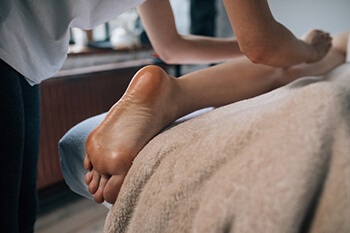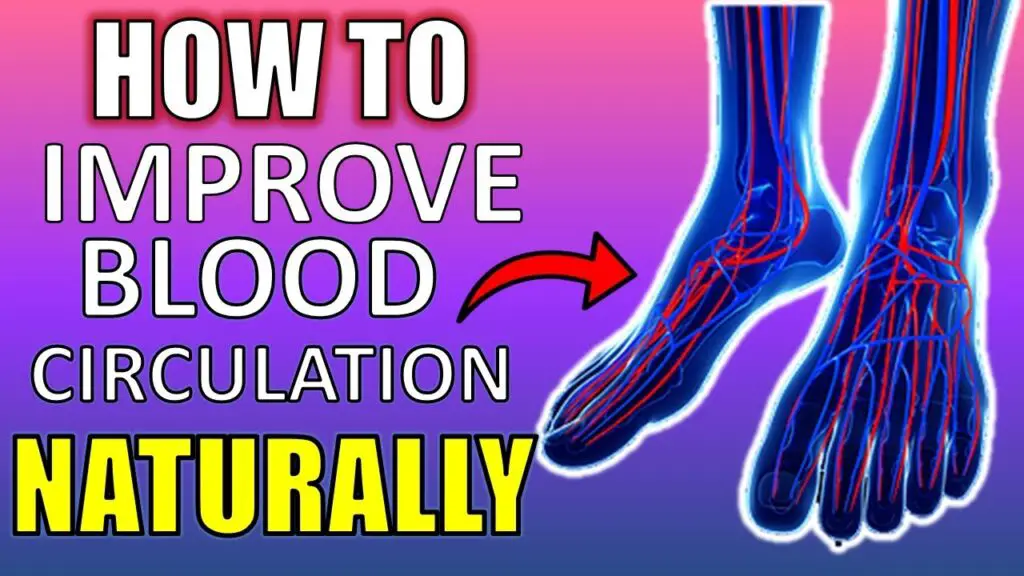Poor blood circulation is often thought of as something that comes with age - unpleasant, but unavoidable.
This isn't quite true. While age certainly can play a factor in poor circulation, there can be a variety of causes. That isn't to say that poor blood circulation is something you should simply put up with. With a little time and research, there are plenty of natural remedies to help alleviate the symptoms of poor circulation.
The legs tend to be particularly badly affected by poor blood flow, with an increased risk of blood clots. Fortunately, there are ways to improve blood circulation and reduce your symptoms. Let's discuss some natural treatments that you can use at home.
Causes and Symptoms of Poor Blood Circulation
Any number of conditions can cause poor blood flow. For example, advanced age, obesity or an inactive lifestyle can cause blood flow to suffer, but it can also be caused by more serious health issues, like diabetes or deep vein thrombosis.
The symptoms of poor circulation in your legs can range from minor discomforts to more serious problems. Here are a few signs that you could be suffering from poor blood flow:
- Aches, pains, numbness, or tingling in the legs
- Discoloration in the legs and feet
- Swelling in the legs and feet
- Swollen arteries and veins
- Poor or nonexistent hair growth on the legs and feet, slow-growing toenails
- Split or weeping skin
- Ulcers
It's always wise to get a medical expert's opinion on the causes of your poor blood flow. Once you know your issue, it's time to work out treatments. As you can see, these symptoms by themselves are unpleasant and can cause other issues. So how can you deal with poor circulation?
Treatments
You should treat bad circulation in your legs with a combination of natural remedies, exercises, and lifestyle changes. For example, if a sedentary lifestyle or obesity is causing the issues, try and make changes.
Exercise
Movement is a great way to increase blood circulation and improve overall cardiovascular health. Exercise gets the heart pumping and the blood moving. If you're not used to regular exercise, start gradually. In time, you can build up your routine. Here are a few simple exercises that you can do to begin with.
1. Walks

For a beginner, walking is the best exercise. Talking a walk allows you to stretch your muscles and get your blood flowing, all without overtaxing yourself - and better yet, it's completely free, no gym membership required. If you're planning to build up your exercise routine gradually, start by taking just a few short walks a day. These walks don't have to be more than a few minutes.
As you feel more confident, start walking for longer, at a faster pace. The beauty of walking is that it's easy to adjust your schedule to fit yourself. Taking a walk from time to time is especially important if you have a sedentary job or lifestyle. Sitting at a desk all day isn't good for blood flow. Get up regularly to walk around and stretch.
2. Yoga

Yoga is known to stretch out and relax the body, which can improve circulation and lower blood pressure. You can start with easy, basic positions, and move up to more complex workouts. Yoga is a low-impact exercise, meaning it works out your body without seriously straining your muscles.
If you suffer from high blood pressure, an increased risk of blood clots, or diabetes, look for a yoga routine specifically designed to work for people with these health issues. There are plenty of free yoga workout videos for beginners to follow online.
3. Elevate Your Legs

One symptom of reduced circulation in legs is edema, a buildup of fluid that causes stress or swelling in the legs, feet, and ankles. It's the most commonly known sign of poor blood flow, although not everyone with blood circulation issues experiences this.
This swelling can lead to other problems, such as split, weeping skin and discoloration. A way of quickly dealing with edema is to elevate your legs, especially if you've been sitting for a long time. You can use a sofa, footstool, or just another chair to keep your feet elevated. This can work as a preventative measure, or as a way of naturally easing stress or pressure.
4. Leg Exercises
Simple leg exercises are a good way to improve circulation in your legs and increase blood oxygen in your arteries. It can also help to stretch out the muscles in your legs and feet. Most of these exercises can be done sitting down, or even lying down. You don't require any specific pieces of equipment
Ankle Flexes
Do this exercise lying down. Lie on your back, with your feet held straight. Flex first one foot, then the other. This is a simple stretching exercise that shouldn't cause any strain, but it helps to stretch out your ankles. Flex each foot at least ten times. You're free to do this as many times as you'd like per day.
Ankle Twists
Once you're comfortable with the ankle flexes, it's time to move onto twists. Sit down and lift one foot off the floor. Gently rotate the foot first clockwise, then anticlockwise. Repeat ten times for each direction, then do the same for the other foot.
Knee Flexes
Lie on your back, just like you did for the ankle flexes. Bend one leg, bringing your knee as far back to your chest as you can, and back again. Don't pull your leg further back than is comfortable. Repeat with the other leg, and do the whole exercise around ten times.
Calf Raises
This is something you can do standing up. Using a chair for balance, gradually move up onto your tiptoes, then lower your heels back to the ground. This should be a slow, controlled movement. You may feel strain in your calves after a few reps. This is usually a sign that your muscles are working. However, don't push yourself further than you feel comfortable.
Squats

Squats are a versatile exercise that have a place in just about every workout routine. Once you're comfortable with all the previous exercises, you could try adding a few squats to your regimen.
A basic squat is very simple. Start in a relaxed but alert standing position, feet a hip's width apart. Extending your arms for balance, gradually lower yourself until your thighs are parallel to the floor. However, don't lower yourself further down than is comfortable. Your back should be straight, and your knees should be in front of your toes. Start with shallow squats.

Lifestyle Changes
Exercise and movement is a vital component of dealing with poor blood flow. However, maintaining a healthy lifestyle can have a serious impact on your blood flow - for better or for worse. A doctor will likely be able to advise you on how your lifestyle is affecting your blood flow. There are several things you can do to improve your blood flow and overall health.
1. Quit Smoking

Nicotine causes blood vessels to tighten. This, in turn, restricts blood flow. Smoking can have an impact on your blood circulation, as well as causing other serious health problems. If you're serious about improving your circulation, you should consider giving up tobacco altogether.
2. Eat a Healthy Diet

Following a balanced diet is a great way to ensure that your body gets all the nutrients it needs for good health. This contributes to healthy blood vessels, veins, and arteries. Certain health foods such as omega 3-containing fatty fish, onions, and garlic are known to increase your blood circulation and prevent blood clotting in the body. A good diet also helps you stick to a healthy weight.
3. Stay Hydrated

Our organs need plenty of water to work to full capacity, and the heart is no exception. It's vital to stay hydrated for properly flowing blood. Some people wait until they're thirsty to drink, but that's often too late.
The average human body needs approximately 2.5-3.5 liters of water a day. If you're living an active lifestyle, you'll need to drink more to replace you water you've lost during your workouts. Similarly, if the water is very warm, you'll need to replace the water your body is losing by sweating.
4. Get Professional Massages

Massages can help you to relax. Muscles can tense up without us realizing, and this can affect our circulation. A quick self-massage for your legs is another of the ways to improve blood flow and relieve pressure if you've been standing or sitting in one position for too long.
5. Wear Compression Stockings
Compression stockings or socks can help to boost blood flow, ensuring that oxygen and nutrients can travel properly in your circulatory system. Compression stockings come in a variety of styles, sizes, and pressures.
While heavy-duty compression garments are available, you can also find some that are as light and simple as firm socks. If you have a job that requires a lot of standing, wearing compression socks can be a good way of keeping your circulation going while you're working. Search for compression socks online and you'll find there's plenty of choice.
6. Take Warm Baths

A soak in a warm bath can go a long way to help boost circulation, relieve pressure and increase your blood oxygen. Saunas and steam room treatments can also be good for circulation. For these treatments to help, it's good to make sauna visits and warm baths part of your daily routine.
Daily Changes for Better Circulation
Once you and your doctor have established the medical cause of your poor blood flow, you can start working towards fixing it. Lifestyle changes and working out are the absolute best ways to boost circulation. In our busy lives, making time to stay fit and healthy isn't always easy.
However, many of the simple leg and foot exercises can be done in the workplace, even at your desk, and it's easy to add healthy alternatives to your diet to replace unhealthy foods.
Some people invest in under-desk cycle machines, allowing you to use your feet to pedal while you relax or work at a desk. This can help boost your circulation, exercises your muscles, gets your heart pumping, and burns calories, even helping you to lose weight.
It's always wise to consult a medical expert before beginning a new natural treatment for poor blood circulation. Be sure to monitor your progress, and keep an eye out for worsening symptoms.
You should especially consult a doctor if you think you have high blood pressure, as elevated blood pressure may make your arteries less elastic, which will prevent you from maintaining a healthy circulation. However, there's no reason why you can't usually improve blood circulation right there at home.

